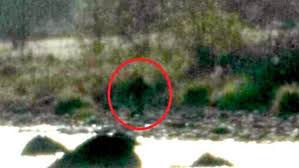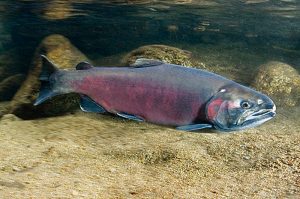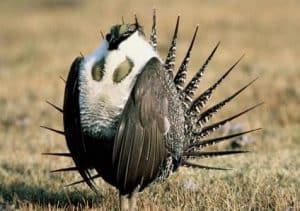Sighted last March. They’re probably a good indicator of ecological integrity.
Diversity and species conservation
Flathead forest plan revision nears finish line
I’ve been looking at the second final forest plan and EIS prepared under the 2012 Planning Rule, the Flathead. I want to commend them for some of the things they’ve done.
They have done a very good job of describing desired conditions for many vegetation characteristics based on their natural range of variation. I can tell you that this is the kind of “specific” desired conditions the drafters of the Planning Rule had in mind for providing ecological integrity. They also conducted an analysis of how vegetation conditions would change over time as a result of the plan, while factoring in expected fire regimes, and they were able to use this for some of their analysis of effects on viability of wildlife species that are closely tied to vegetation. I pretty much only looked at the wildlife parts of the EIS, but I thought the terrestrial part was well organized, and included some thoughtful discussion of what plan components actually do. One of my interests is habitat connectivity, and they have given it a more serious look than most, including actually considering and identifying specific areas to be managed for connectivity.
I was looking for problems related to at-risk species, and there are some. Regarding fire, even though they don’t call the wildland-urban interface a “management area,” it is one because a lot of plan components apply differently there.
I’ve also seen how big of a job it is to review and understand something this massive within 60 days, even with only a limited focus – and I’m someone with probably as much experience at this as anyone. It helped to have followed this process off and on from the beginning, but I have some sympathy for organizations trying to promote changes at this point in the process. (There’s much more time to prepare for forest plan litigation.)
Next up? The Inyo is on track for “this spring.”
What if forest plans were a blank check?
There’s an interesting observation in this opinion piece about the process for amending the Allegheny forest plan to allow construction of the Atlantic Coast Pipeline. It required replacing standards in the forest plan for this “project” – here’s one of them:
“Standard SW06: Severe rutting resulting from management activities shall be confined to less than 5 percent of an activity area with the exception of the construction of Atlantic Coast Pipeline, where the applicable mitigation measures identified in the COM (Construction Operations & Maintenance) Plan and SUP (Special Use Permit) must be implemented.”
The problem this author points out is that the COM was written by the permittee and it wasn’t written when the public NEPA process was going on. The result was the Forest essentially writing a blank check for plan components that the Forest did not evaluate the effects of and the public did not get a chance to comment on. I think there’s some (legal) problems here.
This story got my attention because I’ve been looking at a lot of plan components being proposed for forest plans being revised under the 2012 Planning Rule. One common theme is to not make any commitments in a forest plan, often using language that says essentially, “we’ll figure it out later,” often project-by-project. It’s kind of hard to evaluate the effects of that forest plan decision. Sometimes it’s kind of like this example – where the forest plan defers to someone else, for example the states to tell them how to manage for wildlife. But there’s an even bigger problem when there are legal requirements that a forest plan must meet, particularly those related to plant and animal diversity. A plan component that writes a blank check for a future decision does not demonstrate legal compliance.
Forest planning heats up on the Custer-Gallatin
It looks like the Forest has at least two alternatives now for wilderness recommendations, with competing proposals from a local wilderness group and a “partnership” that includes a state wilderness group. (What should count more, local or collaborative?). An interesting comment from the local group:
“I recently met with the Custer/Gallatin National Forest supervisor regarding the forest plan revision available for public comment. She cautioned me to limit my comments to science-based concerns rather than value-based. I have a problem with that.”
That disagreement sounds like one we have discussed before.
Then you’ve got bison (and protesters). It’s a pretty unique situation, but triggers the standard requirement for the Forest to determine if there is substantial concern about their persistence in the plan area, which would require them to be formally treated as a species of conservation concern and maintain habitat for a viable population. They can’t just say they’ll do whatever the state wants, or whatever the Park Service wants, or assume that those other parties would ensure that the species persists on the Forest.
Study blames pot farms for poisoning spotted owls
“Researchers from the University of California, Davis, and the California Academy of Sciences tested 10 northern spotted owls found dead in the region. Seven of the owls tested positive for rat poison, used by pot farmers to keep rodents away from their irrigation systems and crops.”
“California officials argue that legalization will allow them to increase oversight and regulation of cannabis farms in fragile forests.” Is there an opportunity here for California to work with Attorney General Sessions on federal lands since they have a shared interest? Could the revived “war on drugs” lead to more money for the Forest Service? (This is slightly tongue-in-cheek, but …)
(Another opportunity … for those cut-over private timberlands to improve their cashflow? Not that this would be any better for the spotted owls, though rat poison would also work on barred owls attracted to the clearcuts.)
Loggers lose attempt to remove coho salmon from California’s endangered list
On remand from the California Supreme Court, the Central Coast Forest Association and Big Creek Lumber Company lost again in the state appeals court. They have been arguing that coho salmon did not occur naturally in rivers south of San Francisco, and that hatchery coho were harming native steelhead. The state Fish and Game Commission had found otherwise.
From the judge: “Petitioners have not offered sufficient evidence that the current inhabitants of the streams south of San Francisco are directly the result of out-of-state hatchery stock,” he wrote. “Moreover, the Commission relied on recent genetic data, the results of which rule out the claim that hatchery fish replaced the native stock south of San Francisco.”
From an environmental intervenor attorney: “The petitioners/plaintiffs are timber companies, not advocates for steelhead,” he said, noting that the appellate court’s ruling blames timber harvesting in part for the decline in coho populations. “It seems pretty transparent that their interests lie in reducing restrictions on timber operations, not protecting salmon or steelhead,” Evans added. “Protections for waterways that contain coho salmon would also benefit steelhead trout in those same rivers. So, in essence, greater protections against sediment, erosion, roads, and increases in water temperature due to timber harvest would benefit both salmon and steelhead, which have similar ecological needs.”
From the plaintiffs’ attorney: “It’s sad to see the deepening corruption of science in California. It’s just another layer of regulation and stupidity,” he said. “This decision is sinking California into a pit of idiocy from which it will never return.”
It sounds to me like it’s just typical judicial deference to a professional agency’s interpretation of science. And for lumber companies to say they are only concerned about the fish – that sounds a little “stupid” (but whatever it takes to try to win the case, right?).
Forest Service on the bandwagon to unprotect sage grouse
Time is running out to comment on the notice that initiated “the scoping process to solicit public comments on greater sage-grouse land management issues that could warrant land management plan amendments” on 15 national forests and grasslands. (Comments are due Friday.) The majority of sage grouse habitat is found on BLM lands (I think the Forest Service has 8%) and the Forest Service is following behind the Department of Interior’s lead to “consider” rolling back restrictions, especially those that interfere with oil and gas drilling. Those restrictions were added to Forest Service and BLM plans in amendments that were adopted in 2015 pursuant to the 1982 planning regulations for species viability, and have been credited with avoiding the need to list sage grouse as threatened or endangered. The Forest Service concedes that amendments it would propose would be likely to be “directly related” to, and therefore subject to, the new diversity and viability requirements of the 2012 Planning Rule. More background from the Forest Service here.
Shoshone forest plan lawsuit leads to negotiated solution on pack goats
The North American Packgoat Association’s lawsuit reversed a forest plan decision to restrict the use of goats for packing (because of risk of disease spreading to bighorn sheep) based on a procedural violation. They then got together with the National Wild Sheep Foundation and other stakeholders to work out a new plan, which the Shoshone just adopted (presumably as a forest plan amendment, though the Forest website has no information about it).
The balance that was struck prohibits pack goats from territory used by core bighorn sheep herds in the Absaroka Range and Wind River Mountains. It was a concession the goat packers were willing to make, partially because of lack of use and the undesirable nature of the Absaroka as a goat packing destination.
“North of Whiskey Mountain is infested with grizzlies,” Jennings said. “Frankly I didn’t want to go in there anyway.”
Permits will required to bring the pack animals into the Shoshone in areas where they are allowed, which include the entire Washakie Ranger District and the southern reaches of the Wind River Ranger District. The Temple Peak Herd roams the area between the two pack-goat-friendly zones, but the Wyoming Game and Fish Department manage it as a lower-priority herd. The state agency agreed with the Shoshone that the Temple Peak sheep could be subject to a higher level of risk.
The Shoshone’s decision also calls for goat packers to abide by a strict set of rules, like stringing no more than three animals per person, leashing their goats and possessing proof of vaccinations.
Possibly in the background was the result of another lawsuit finding that extirpation of a “lower-priority” herd of bighorn sheep could be a violation of NFMA.
How “collaboratives” work in Idaho
They work well, according to this article, and here’s probably an important reason why:
“The collaboratives advance the process by removing features that are sure to invite challenges and delays — like proposing new roads in a roadless area.”
My impression has been that it is easier to reach agreement on protecting undeveloped areas (or not) in both project plans and forest plans than it is to agree on conservation strategies for wildlife (which are the basis of a lot of litigation). Maybe the former is more political, which lends itself to negotiations, and the other is more scientific and/or legal, which does not? (Or maybe I’m imagining this difference.) Spending money to restore damaged streams also seems to work as a bargaining (for wood) chip.
Earth Island Institute v. Elliott (E. D. California)
This case was decided on November 16, but has not yet been included in a Forest Service litigation summary. At issue is the Bull Run project, a fire salvage restoration project to treat a strip of land along an area of roadways affected by the Cedar Fire on the Sequoia National Forest. The court denied the motion for a preliminary injunction. The Forest determined that the project could be categorically excluded from an EIS, and that there were no extraordinary circumstances that would prevent the use of a CE.
The court determined that the main issue involving the use of a CE was “whether it is reasonable to interpret a project that “salvages” hazard trees on a large scale as “routine road maintenance.” Here is the CE:
(4) Repair and maintenance of roads, trails, and landline boundaries. Examples include but are not limited to:
(i) Authorizing a user to grade, resurface, and clean the culverts of an established NFS road;
(ii) Grading a road and clearing the roadside of brush without the use of herbicides;
(iii) Resurfacing a road to its original condition;
(iv) Pruning vegetation and cleaning culverts along a trail and grooming the surface of the trail; and
(v) Surveying, painting, and posting landline boundaries.
After reviewing several similar cases, the court concluded, “the Court cannot determine with certainty at this stage of the case to what extent the Bull Run project is a true commercial “salvage” operation or whether it is, in practice, more like the Nez Perce project (which denied it was a salvage project), or whether, possibly, this is a distinction without a difference.” The court held: “For purposes of this motion for a preliminary injunction, the Court need not definitively determine the issue on the merits; it is enough to conclude that success on the merits as to the CE issue is unclear.” Thus plaintiffs had not made their case for likelihood of prevailing. (I think the FS got away with one here, especially because there is another CE for salvage projects, but for limited acreage; maybe it will become more “clear” at trial.)
The court found no extraordinary circumstances with regard to the federally endangered mountain yellow-legged frog and the Pacific fisher and California spotted owl (both designated as sensitive species by the Forest Service). For the spotted owl, the court determined that the Forest had adequately considered information about their use of post-fire areas (including submissions from the John Muir Project and Chad Hanson). Lack of quality fisher habitat swayed the court to accept the FS explanation regarding fisher connectivity. The project included 30 “site-specific measures” designed to minimize the risks to the frog, and the court cited the FWS conclusion that the resulting risk to individuals was low. (These measures would be good candidates for forest plan components when the Sequoia revises its forest plan.)



